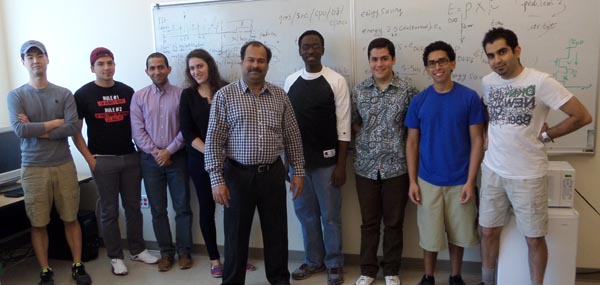WSU Undergraduate Research Heats Up while Students Cool Down Computers
MEDIA CONTACT: Jared Brickman, Communications Assistant, Office of Undergraduate Education at WSU, 509-335-8070, UCHCCommMar.4@wsu.edu
SOURCE: Partha P. Pande, Professor, EECS, 509-335-5223, pande@eecs.wsu.edu
PULLMAN, Wash. — Behind the quiet whir of our computers and beneath the flashing screens of our cell phones lies hardware soaking up power and giving off heat. That can be a major problem – one to the tune of 100 billion kilowatt hours of energy used each year, according to the Environmental Protection Agency (EPA).
Ten undergraduates from around the country, including four from Washington State University, are working on projects this summer with WSU faculty and graduate students in Pullman to tackle the issue of power efficiency in computing through a National Science Foundation (NSF) sponsored Research Experience for Undergraduates (REU).
Arriving at WSU in late May, these students were immersed immediately into faculty-mentored projects focused on the question of how to make power- and thermal-efficient computer systems, explains Partha Pande, professor of computer engineering at the School of Electrical Engineering and Computer Science (EECS) in the College of Engineering and Architecture. He is a co-principle investigator (PI) on the grant.
“We’re really trying to go beyond surface settings like putting your computer on standby,” says Behrooz Shirazi, PI, Huie-Rogers Chair Professor, and director of EECS. “This would be behind the scenes and could hopefully be applicable no matter the program being run.”
Though the department has held REU programs in the past, this specific topic was chosen due to its national appeal and timeliness, Shirazi explains. The impact is two-pronged: economic and environmental. Wasted energy is a major concern of the EPA, and researchers see the great savings that could come from making things more efficient, he says.
Four students working with Pande and Shirazi are using a software program called gem5 that simulates the passing of time as a series of discrete events, intended to model computer systems in various ways. These simulations allow researchers to explore what can be done to save on power without diminishing performance.
Several other students are designing hardware – voltage regulators – that could allow the tuning of voltage use in processors. One student is on a research team that plans to continue through to the fabrication of their design.
The students do most of their work on computers, poring over lines of code and data tables or running simulations. Weekly meetings with all the students help to form a collaborative community, despite the work being mostly individual.
Though these current projects pertain to computers, similar designs could be used in all kinds of electronics, from appliances to cell phones, says Pande. Despite the possibilities for real-world applications, he says the true mark of a good researcher is one who “looks for the science” first.
 This concept is central to the REU, a program designed to engage students in a setting outside the classroom, says Shirazi. Though students work on individual projects, the main goal of the program is to introduce mentored research in an environment of science.
This concept is central to the REU, a program designed to engage students in a setting outside the classroom, says Shirazi. Though students work on individual projects, the main goal of the program is to introduce mentored research in an environment of science.
“You have hands-on research here,” says Pande, “and it’s completed alongside current faculty and graduate students. I think that’s a great opportunity for students and it encourages them to think about graduate school. That includes programs at WSU, naturally.”
Part recruiting tool, part unique experience, Shirazi sees the REU as beneficial to both the undergraduates and the department. He’s been involved in REUs for more than 20 years and has one simple piece of advice for all researchers: “Be curious.”